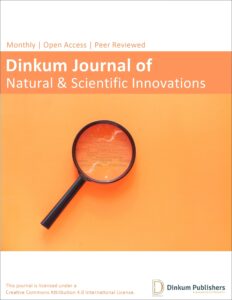Publication History
Submitted: November 16, 2024
Accepted: November 24, 2024
Published: March 31, 2025
Identification
D-0408
DOI
https://doi.org/10.71017/djnsi.4.3.d-0408
Citation
Raquel B. Santos (2025). Setup Project Monitoring and Management System. Dinkum Journal of Natural & Scientific Innovations, 4(03):122-139.
Copyright
© 2025 The Author(s).
122-139
Setup Project Monitoring and Management SystemOriginal Article
Raquel B. Santos 1*
- Department of Science and Technology Region 02, Carig Sur, Tuguegarao City, Philippines.
* Correspondence: raquel.santos@ro2.dost.gov.ph
Abstract: The Department of Science and Technology R02 (DOST02) aims to be the leading STI Hub for fair and excellent service by enhancing its procedures using smart technology. The department recognizes the vital role of Micro, Small, and Medium Enterprises (MSMEs) in employment generation, domestic activity, and innovation. DOST02 and its five Provincial Science and Technology Centers have been working on rural projects for the past fifteen years. SETUP, a national plan, aims to help MSMEs implement technological advancements to enhance their operations and increase production and competitiveness. Since 2002, SETUP projects in Region 02 have grown significantly, with 609M funding to 687 companies. To improve efficiency and effectiveness, DOST02 has created a user-friendly, efficient, and successful integrated management system. The system allows users to control data movement across the entire life cycle, reducing the need for paper records and time spent processing and submitting needs and reports. The availability of SPMAMS online would be a significant advantage for DOST02 staff, allowing them to update records, produce correct reports, accelerate procedures, and remove heavy paper tasks. This study focused on the design, development, and testing of an online-based SETUP Project Monitoring and Management System for the R02 Department of Science and Technology. The system aims to create timely and valuable reports, conform to ISO 25010 Software Quality Standards, and provide access to real-time subsidiary ledgers for beneficiaries. The system will benefit the cashier, customers, Office of the Undersecretary for Regional Operations (OuSecRO), Provincial Science and Technology Centers (PSTCs), and Regional Project Monitoring Office (RPMO). The SETUP Project Monitoring and Management System (SPMAMS) is a web-based system developed by a researcher at the Department of Science & Technology, aiming to support MSMEs in implementing technology advancements to enhance operations and competitiveness. Despite facing challenges in customer profile updating, report preparation, and data storage, the system effectively met end-user needs, achieving a score of 4.83 in ISO 25010 standards. The SETUP Project Monitoring and Management System (SPMAMS) was developed by a researcher, utilizing Java-based web application development and MySQL database. The system was designed to address agency needs, including data storage, monitoring, and administration. Despite facing challenges in customer profile updating, report preparation, and data storage, SPMAMS effectively met end-user needs, achieving a score of 4.83 in ISO 25010 standards.
Keywords: department of science and technology (dost), data, science, system, technologies 25010
1. INTRODUCTION
Providing central direction in the cooperative development and use of Science, Technology, and Innovation in building smarter and disaster-resilient communities through its core values Teamwork Excellence Commitment Competence Integrity (TECCI), the Department of Science and Technology R02 (DOST02) envisioned to be the lead STI Hub for fair and excellent service. As a partner in achieving such goal, DOST02 seeks to enhance its procedures by applying the current smart technology [1]. To remark, the execution of its projects and activities depends much on its internal procedures. Long realizing the vital role Micro, Small, and Medium Enterprises (MSMEs) play as employment generators, promoters of domestic activity, and creators of innovative products and technologies in the nation to realize the goal of continuous economic growth and development of the nation, DOST has long been appreciating them. For the past fifteen years, DOST02 and its five Provincial Science and Technology Centers in Cagayan, Isabela, Nueva Vizcaya, Quirino, and Batanes are constantly finding ways to carry out the department’s rural projects—more especially, the Small. SETUP is a national plan meant to help MSMEs implement technological advancements in order to enhance their operations and thereby increase their production and competitiveness [2]. Through better product quality, human resources development, cost minimization and waste management, and other operation-related activities (DOST Administrative Order No. 002 SETUP Guidelines 2.0), the program helps companies to solve their technical problems by means of technology transfer and technological interventions so improving productivity. SETUP has reached particular benchmarks.609M has been funded to SETUP Beneficiaries (DOST02 SETUP throughout the Years), therefore helping 687 companies altogether. Given the current state of affairs whereby everyone depends on technology, DOST02 has to enhance its internal procedures to boost efficiency and effectiveness in carrying out its banner program – SETUP, thereby improving the whole performance of the company [3]. The created system seeks to help the company to realize its goal of a user-friendly, efficient, and successful integrated management system. It will create a setting where the User may control the movement data or information across the complete life cycle. The paper was delivered personally from the provincial offices to the regional office prior to system deployment. Each of the SETUP recipients has a separate hardcopy record kept by every PSTC [4]. Digital form of records did not exist. It was almost difficult to get any necessary information about any particular SETUP project, including project status or action performed right away. Should it be feasible, it took time. An annual growing quantity of SETUP projects made the situation worst for RPMO and Finance. Managing the projects personally was therefore a quite tiresome task. Furthermore, by only visiting the system online, the proposed solution will help users to access and oversee SETUP projects [5]. Professionals have fresh opportunities for information management as computerization and network use keep developing. Thus, the evolution of SPMAMS of the Department of Science and Technology Region 02 is essential to have online access of the system’s User and to have an efficient and successful operation of its report preparation. Before designing the project, the researcher/developer took numerous elements into account. Among them are the following: a) Show current hand-crafted method for creating reports and turning in documentation b) time spent processing and submitting needs and reports by DOST02 RPMO and PSTC staff [6]. Moreover, the availability of SPMAMS online would be a tremendous advantage, convenience, and comfort for the DOST 02 staff in updating records and profiles, producing correct reports, accelerating procedures, and so removing heavy paper tasks. Data consolidation processes have possibilities for mistakes; so, it is impossible to completely exclude them. Usually, attempts to correct the found mistakes cause delays in the process [7]. Moreover, internet access to be offered to its beneficiaries would be a tremendous aid to be updated in the situation of their payments and accounts. At last, reports accessible to the OuSecRO will be available online. This thus helped to enhance the internal process of DOST02 thereby enabling improved customer service [8]. This study applies input-process-output (IPO). The researcher intends to ascertain the challenges and issues, data sets, policies, and guidelines in the execution of SETUP, which were applied to ascertain what is needed by the system. Analyzing the current system, the study’s input consists in questions, difficulties, and concerns. A prototype developed, shown, and polished in the process phase. The software model applied for the prototype and the software development lifecycle came next. Up until the prototype underwent final testing, several assessments of it were carried out [9]. The interested parties handled this procedure. This study under the output phase produces the proposed SETUP Project Management and Monitoring System. The SETUP Project Monitoring and Management system of DOST-R02 was intended generally to be designed, developed, and implemented. It sought, more especially, create timely and valuable reports including payments, supplier information, project maintenance, evaluation, and others; also, create a system that conforms with ISO 25010 Software Quality Standards by means of an online SETUP reporting process securely accessible by authorized DOST-R02 personnel [10]. The proposed system is to benefit various stakeholders, including the SETUP recipient, customers, and the Office of the Undersecretary for Regional Operations (OuSecRO). It will update accounts of every SETUP recipient, provide real-time subsidiary ledger access, and benefit future scholars. The system will also enable the submission of data for monitoring and evaluation of projects by Provincial Science and Technology Centers (PSTCs). The Regional Project Monitoring Office (RPMO) will function as a data bank, providing status updates, analysis, and reporting [11]. The system will be beneficial for the company in monitoring and assessing projects, especially for the growing number of beneficiaries. The study defined terms such as Centre Manager (CM), Data flow diagrams, evaluation, monitoring, Project Information Sheets (PIS), and the Regional Project Monitoring Office (RPMO) at DOST 02, which ensures program execution in accordance with national guidelines and policies. With debits and credits in separate columns and a beginning and ending monetary balance for every account, the subsidiary ledger-computer file records and totals economic transactions measured in terms of a monetary unit of account-by-account type. Designed nationally, the Small Enterprise Technology Upgrading Program (SETUP) aims to support MSMEs in implementing technology advancements to enhance their operations and increase their competitiveness and output. A web application is a software system using a web browser to offer a user interface.
2. MATERIALS AND METHODS
The study applied a descriptive and developmental research design. As gathering data, the researcher aimed to understand the viewpoints, experiences, and issues found in the manual system. Descriptive research uses some of the popular data collecting techniques—such as surveys and interviews—on questions.
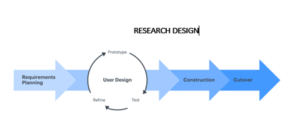
Figure 01: Rapid Application Development
It applied Rapid Application Development in the Development Research Design. The study, design, development, testing, implementation of the created system, and other processes drew their foundation from this approach. The researcher engaged in the following using the RAD approach: Requirement Analysis and Planning. During this phase, the researcher gathered data to ascertain the need and issues found in the current system, so guiding the construction of the system. To ascertain the system needs, interviewed the subjects of the study design here. Based on the acquired requirements, the conceptualized database design and structure, and the system architecture, the researcher deduced the likely output of the system. Most specifically in the office of the Field Operation Services, the researcher also presented and spoke with the users to get their opinions, criticisms, and recommendations for the evolved system. Fast building [12]. The study worked in the development and testing of the system in this phase to ensure that everything was running as expected and that the output satisfied the needs of the end users and research objectives. This phase was crucial since the client still required to provide comments all during the process. They recommended tweaks, adjustments, or even fresh concepts to address evolving issues. Cutover is The launched final product came from the implementation stage. Along with user training, it covered data conversion, testing, and switch to the upgraded system. Every improvement was done while clients and programmers kept searching the system for flaws. This study was carried out at Regional Office 02 of the Department of Science & Technology. Every participant comes from the Regional Office; officials from Provincial offices and the Accounting Unit also attend. Considering the problems and issues users of the current system faced, the researcher was in charge of the general design and development of the system. The system administrator charged with adding, changing, removing user accounts will be the RPMO user. The cashier responsible for entering and updating client subsidiary ledgers will be from the accounting unit. Additionally, in charge of entering consumer monitoring and assessment data will be the PSTC staff. Random selection of the study participants allowed the SETUP Project Monitoring and Management System for DOST 02 to be tested and validated.
Table 01: Number of respondents

The DOST Staff was handed an interview guide. The survey instrument serves as the guide in data collecting. The efficiency of the created system was tested in the post-survey using the ISO 25010 Survey Questionnaire. Appropriate data and information for the study were gathered using the following tools: Interview: Regarding the study, the researcher posed enquiries. This ongoing approach helped to progressively create a model for the system and acquire knowledge of the shortcomings of the present one. Interview form. The quality of the created system was evaluated by the researcher using ISO 25010 Software Quality Characteristics [13]. The Researcher’s collected data were compiled and arranged for study and interpretation. Percentage Count and Frequency This instrument helped to evaluate the current procedures and identify the issues found in the transactions. Weighted Mean This helped one ascertain the degree of success of the created SETUP Project Monitoring and Management System. Likert Scale. Using the post-survey questionnaire, this scale was applied to obtain the point scales and descriptive equivalent of the responses on the current system as well as the proposed system. The descriptive equivalent shown below corresponds to the Four (4) and Five (5) point scales.
Table 02: Point Scale
| Scale | Mean Range | Descriptive Interpretation |
| 5 | 4.20-5.00 | Very Great Extent |
| 4 | 3.40-4.19 | Great Extent |
| 3 | 2.60-3.39 | Moderate Extent |
| 2 | 1.80-2.59 | Little Extent |
| 1 | 1.00-1.79 | Very Little Extent |
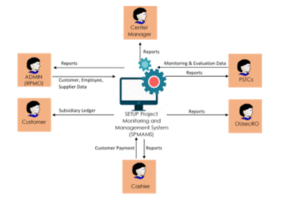
Figure 02: System Architecture
The intended design and operations of the produced system were achieved with suitable software tools. One of the more ancient and widely used languages in which web applications have evolved is Java. In the course of the created project, Java-based web application development utilizing Servlets and JSP is most relevant [14].
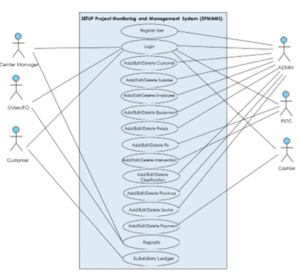
Figure 03: Use Case Diagram
Java is a rigorous object-oriented language in which every function call is meant to either static methods of classes or non-static methods triggered via class instances. These classes are arranged into namespaces known as packages such that unqualified class names do not require global uniqueness. Widely used in the industry for web applications, Tomcat is a free open-source implementation of J2EE web containers offered by the Apache Software Foundation. Added to HTML files, Java Server Pages (JSP) are a notation allowing per-request functionality to be included to otherwise statically-defined HTML [15]. The study selected JSP since the web container compiles the JSP files at runtime to find syntax mistakes there at runtime. Placing this code inside Servlets detects syntax issues at compile-time, therefore enabling early detection and correction of these mistakes. Along with moving controller logic into Java Servlets, the Servlet method also moves database access and other logic into Java beans, so activating most of the Java bean capability from the servlets. Although there are several approaches to create Java-based web applications, the researcher used what is sometimes known as the model-view-controller (MVC) architecture. Persistence and business logic (model), user interface generation (view), and user input (controller) are the three areas of interest the MVC approach tries to separate code into. Usually used in Java applications, MVC is accomplished by creating HTML from Java Server Page (JSP) scripts and servlet handling of received requests [16]. Data access objects (DAOs) help to persist data; business logic is housed inside servills or other classes. The back-end database, which housed all of the records, was MySQL as well.
Table 03: Software and Hardware Specifications
| Hardware | Description |
| Minimum Requirement: | |
| Processor | Intel Core 2/AMD |
| Memory (RAM) | 2GB |
| Hard disk | One SAS/SATA 72GB HDD |
| Suggested Requirement: | |
| Processor | Intel Quad core |
| Memory (RAM) | 4GB DDR3 1033 |
| Hard disk | One SAS 72GB HDD |
| Operating System | Windows |
| Software | |
| Programming tool | JAVA Eclipse |
| Database | MySQL |
| Reports | iReport |
| Server | Apache Tomcat Server 4.1.3/Higher |
| Connectivity | Thru Internet |
3. RESULTS & DISCUSSION
The design, implementation, and testing of an online system for DOST02 is covered in this study together with the functional range of work of the “SETUP Project Monitoring and Management System for DOST02”. Authorized DOST-R02 staff should securely access an online SETUP reporting mechanism that automates project monitoring, evaluation, and technology transfer procedure. The created system was built employing the acquired knowledge and data by means of the following: The agency’s need of an online system Having an online system will be very helpful to the five (5) staff members engaged in the project implementation monitoring in the storage of data, project monitoring, and administration considering the rising number of SETUP Beneficiaries based on the interview findings. The current mechanism applied in SETUP beneficiary monitoring Compiled each province and year, the data reveals that the DOST Staff continued to submit physical reports using the manual approach. When creating reports needed by the Central Office or other agencies, these reports were also personally scrutinized. This problem produced slowing down of report generation and preparation. Problems and conflicts Found encountered by the DOST with the current system in terms of customer profile updating, report preparation, report submission, SETUP data storage, and report preparation. Regarding the usage of the current system in the monitoring of SETUP beneficiaries, the PSTC staff finds it challenging, particularly in the creation and submission of reports employing the manual submission of the accomplished physical form. Like the Regional Office in the aggregation of reports and data conversion to analysis, one of the concerns expressed to SETUP beneficiaries was real-time access of the account ledger. Since the development depends on an evaluation of the demands of the end-users, which is the DOST staff and its SETUP Beneficiaries, these difficulties and issues discovered were used as inputs or requirements to create the online system. From its keeping of customer profiles, updating of project status, updating of repayment, generation of reports, these cover all the extent of work the office undertakes. Create timely and worthwhile reports including payments, supplier data, project maintenance, evaluation, and other aspects. The outcome reveals that the SETUP Project Monitoring and Management System was effectively built and applied in line with the need of the end users. Including its provincial offices, it can greatly assist the regional office in updating and synchronizing data to provide accurate reports to be sent to the central office and its clients [18].
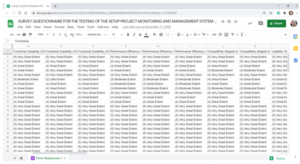
Figure 04: Respondents responses
Functional Sustainability; Performance Efficiency; Compatibility; Usability; Reliability; Security; Maintaining ability; Portability; Degree of Compliance of the Developed System to the ISO 25010
Table 04: Extent of Compliance of the Developed System to ISO 25010 in terms of Functional Sustainability Quality Standards
| Functional Completeness | Weighted Mean | Descriptive Interpretation |
| Functional Appropriateness | 4.82 | Very Great Extent |
| Functional Correctness | 4.84 | Very Great Extent |
| Functional Completeness | 4.88 | Very Great Extent |
| Overall Weighted Mean | 4.86 | Very Great Extent |
With a mean of 4.88 and a descriptive interpretation of “Very Great Extent,” the functional completeness clearly has the highest numerical value shown in the above table. Functional correctness with a mean of 4.84 follows it; the lowest is functional appropriateness with a mean of 4.82 and a descriptive interpretation of “Very Great Extent.” With a descriptive interpretation of “Very Great Extensive,” the overall category mean on the degree of conformity of the designed system to ISO 25010 on functional sustainability is 4.86. Particularly in real-time customer ledger viewing, it was discovered that the system does the necessary work satisfactorily. Table 5 indicates, in terms of performance efficiency criteria, the degree of compliance of the created system to ISO 25010.
Table 05: Extent of Compliance of the Developed System to ISO 25010 in terms of Performance Efficiency Quality Standards
| Performance Efficiency | Weighted Mean | Descriptive Interpretation |
| Time behavioral | 4.80 | Very Great Extent |
| Resource Utilization | 4.84 | Very Great Extent |
| Capacity | 4.80 | Very Great Extent |
| Overall Weighted Mean | 4.80 | Very Great Extent |
With a mean of 4.88 and a descriptive interpretation of “Very Great Extent,” the preceding table clearly shows that resource use has the highest numerical value. Time behavioral and capacity follow it with the same mean of 4.84 and a descriptive interpretation of “Very Great Extent”. With a descriptive interpretation of “Very Great Extensive,” the overall category mean on the degree of compliance of the created system to ISO 25010 on performance efficiency is 4.80 [19]. It was discovered that, under given conditions, the system offers functions that satisfy declared and implied needs. Table 06 lists, in terms of compatibility quality criteria, the degree of conformance of the created system to ISO 25010.
Table 06: Extent of Compliance of the Developed System to ISO 25010 in terms of Compatibility Quality Standards
| Compatibility | Weighted Mean | Descriptive Interpretation |
| Co-existence | 4.82 | Very Great Extent |
| Interoperability | 4.80 | Very Great Extent |
| Overall Weighted Mean | 4.80 | Very Great Extent |
With a mean of 4.82 and a descriptive interpretation of “Very Great Extent,” the co-existence has the highest numerical value shown on the above table. It comes after interoperability with a mean of 4.80 and a descriptive interpretation of “Very Great Extent.” With a descriptive interpretation of “Very Great Extensive,” the overall category mean on the degree of compliance of the designed system to ISO 25010 is 4.80. Table 07 presents the degree of usability quality criteria compliance of the produced system to ISO 25010.
Table 07: Extent of Compliance of the Developed System to ISO 25010 in terms of Usability Quality Standards
| Usability | Weighted Mean | Descriptive Interpretation |
| Appropriateness Recognisability | 4.90 | Very Great Extent |
| Learnability | 4.86 | Very Great Extent |
| Operability | 4.86 | Very Great Extent |
| User Error Protection | 4.82 | Very Great Extent |
| User Interface Aesthetics | 4.84 | Very Great Extent |
| Accessibility | 4.88 | Very Great Extent |
| Overall Weighted Mean | 4.86 | Very Great Extent |
With a mean of 4.90 and a descriptive interpretation of “Very Great Extent,” the appropriateness recognisability has the highest numerical value seen in the table. Accessibility follows with a mean of 4.88 and a descriptive meaning of “Very Great Extent”. Then, the user error protection with a mean of 4.82 and a descriptive interpretation of “Very Great Extent” has the lowest and the Learnability and operability with the same mean of 4.86. With a descriptive interpretation of “Very Great Extensive,” the overall category mean on the degree of conformity of the created system to ISO 25010 on usability is 4.86 [20]. The particular aims and objectives of the system were determined to be satisfactorily fulfilled with efficiency and effectiveness. Table 08 displays, in terms of dependability quality criteria, the degree of conformity of the proposed system to ISO 25010.
Table 08: Extent of Compliance of the Developed System to ISO 25010 in terms of Reliability Quality Standards
| Reliability | Weighted Mean | Descriptive Interpretation |
| Maturity | 4.84 | Very Great Extent |
| Availability | 4.86 | Very Great Extent |
| Fault Tolerance | 4.76 | Very Great Extent |
| Recoverability | 4.84 | Very Great Extent |
| Overall Weighted Mean | 4.86 | Very Great Extent |
With a mean of 4.86 and a descriptive interpretation of “Very Great Extensive,” the availability has the highest numerical value shown from the table. With a mean of 4.84 and a descriptive interpretation of “Very Great Extent,” it is followed by maturity and recoverability; the lowest is fault tolerance with a mean of 4.76. With a descriptive interpretation of “Very Great Extensive,” the overall category mean on the degree of compliance of the designed system to ISO 25010 on reliability is 4.86. The end users’ expectation that the data entered into the system were the accurate data from their records caused the variance of 0.14. Ignoring the mentioned variation, it was discovered that the system satisfied dependability criteria under regular running conditions.
Table 09: Extent of Compliance of the Developed System to ISO 25010 in terms of Security Quality Standards
| Security | Weighted Mean | Descriptive Interpretation |
| Confidentiality | 4.84 | Very Great Extent |
| Integrity | 4.84 | Very Great Extent |
| Non-repudiation | 4.82 | Very Great Extent |
| Authenticity | 4.78 | Very Great Extent |
| Accountability | 4.78 | Very Great Extent |
| Overall Weighted Mean | 4.82 | Very Great Extent |
With a mean of 4.84 and a descriptive interpretation of “Very Great Extensive,” the table clearly shows that honesty and confidentiality have the highest numerical value. Non-repudiation with a mean of 4.82 follows it; the lowest is authenticity and responsibility with the same mean of 4.78 and a descriptive meaning of “Very Great Extensive.” With a descriptive interpretation of “Very Great Extensive,” the overall category mean on the degree of compliance of the designed system to ISO 25010 on security is 4.82. The necessary operations of the system were found to be satisfied by the several user levels that stop illegal system access [21].
Table 10: Extent of Compliance of the Developed System to ISO 25010 in terms of Maintainability Quality Standards
| Maintainability | Weighted Mean | Descriptive Interpretation |
| Modularity | 4.80 | Very Great Extent |
| Reusability | 4.80 | Very Great Extent |
| Analyzability | 4.86 | Very Great Extent |
| Modifiability | 4.78 | Very Great Extent |
| Testability | 4.82 | Very Great Extent |
| Overall Weighted Mean | 4.82 | Very Great Extent |
With a mean of 4.86 and a descriptive interpretation of “Very Great Extensive,” the analysers have the highest numerical value among tables. Testability a mean of 4.82 and a descriptive interpretation of “Very Great Extent” accompany it [22]. Then, modularity and reusability with the same mean of 4.80 and descriptive interpretation of “Very Great Extent” and the lowest is modifiability with a mean of 4.78 and a descriptive interpretation of “Very Great Extent”. With a descriptive interpretation of “Very Great Extensive,” the overall category mean on the degree of compliance of the created system to ISO 25010 on maintainability is 4.82 [23]. The system is apparently open for further improvement. Table 11 displays, in terms of portable quality criteria, the degree of conformance of the designed system to ISO 25010.
Table 11: Extent of Compliance of the Developed System to ISO 25010 in terms of Portability Quality Standards
| Portability | Weighted Mean | Descriptive Interpretation |
| Adaptability | 4.82 | Very Great Extent |
| Instability | 4.86 | Very Great Extent |
| Replace ability | 4.84 | Very Great Extent |
| Overall Weighted Mean | 4.84 | Very Great Extent |
With a mean of 4.86 and a descriptive interpretation of “Very Great Extensive,” the instability has the highest numerical value shown on the table. Replace ability with a mean of 4.84 follows it; the lowest is the adaptability with a mean of 4.82 and a descriptive interpretation of “Very Great Extent.” With a descriptive interpretation of “Very Great Extensive,” the overall category mean on the degree of compliance of the created system to ISO 25010 on portability is 4.84. Running in accessing the internet, it was discovered that the system may run with a minimal necessary hardware and software. Table 14 indicates the general degree of ISO 25010 compliance of the created system [24].
Table 12: Overall Extent of Compliance of the Developed System to ISO 25010
| Quality Standards | Weighted Mean | Descriptive Interpretation |
| Functional Completeness | 4.86 | Very Great Extent |
| Performance Efficiency | 4.80 | Very Great Extent |
| Compatibility | 4.80 | Very Great Extent |
| Usability | 4.86 | Very Great Extent |
| Reliability | 4.86 | Very Great Extent |
| Security | 4.82 | Very Great Extent |
| Maintainability | 4.82 | Very Great Extent |
| Portability | 4.84 | Very Great Extent |
| Overall Weighted Mean | 4.83 | Very Great Extent |
The overall mean assessment for the developed system’s extent of compliance to ISO 25010 is 4.83 or “Very Great Extent”. This implies that the developed system complied with the different parameters of ISO 25010 certifying the quality and functional sustainability, performance efficiency, compatibility, usability, reliability, maintainability, security, and portability [25].
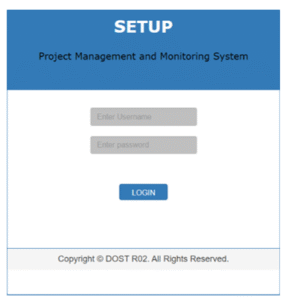
Figure 05: Main page
To login to the system, the User is required to enter a valid username and password on the Login Form
at the center of the Main Page. Enter Username and Password on the entry boxes labeled respectively.
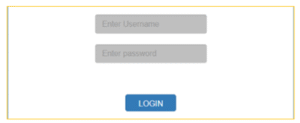
Figure 06: Login Form
Then click the Login button. If login is successful, the User will be directed to the Default Screen. Default Screen
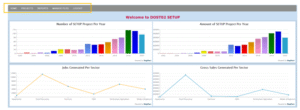
Figure 07: Dosto2 setup
Once logged in to the system, the User will be automatically directed to the Home Section.
Table 13: components of the Default page and a brief description of what they are
| Home Section | Provides links to Default Screen and sub-sections |
| Projects Section | Provides a link to Add new projects, Search projects to manage (Add/Edit/Delete Pre-PIS, PIS, Ledger, Intervention, Equipment and MOA)
|
| Reports Section | Provides a link to Report sub-section to view and print reports |
| Manage Files Section | Provides links to Add/Edit/Delete Province, Sector, Classification, Supplier, Employee, User, Add /Edit for administrator’s access |
| Logout Section | Provides a link to the Main Form and exit in the system |

Figure 08: Projects Sub-section Add
To add a new project to the system, from the Projects sub-section, the User can use Add link button. To add a new project, fill in the entry boxes that constitute the parameters for adding a project. When done, click Submit button to submit the entry.

Figure 09: Add Project
To search a project to manage, from the Projects sub-section, the User can either use the Search link or choose which province to view the list of projects to select from.

Figure 10: Search Engine
To select a specific project using the search engine, type in the project title or firm owner in the Search textbox. When done, click the Search button to display the details of the project. If there are multiple entries for a specific keyword, select a project to display.
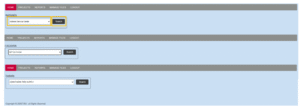
Figure 11: Search Per Province List
To select a specific project using the Per Province List, click the dropdown menu and select project. When done, click the Search button to view details of the project. How to edit project details? From the project detail’s view, click the Edit button to enable editing of project details. When done, click Submit button to submit changes made.

Figure 12: Project Details Section
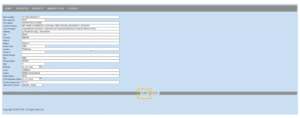
Figure 13: Project Details View

Figure 14: Edit Project Details

Figure 15: Delete Project
From the project detail’s view, click the Delete button to confirm the deletion of the project. To confirm the deletion of the project, click the Yes button.

Figure 16: Pre-PIS View
From the project detail’s view, select section (Pre-PIS, Ledger, PIS, Intervention, Equipment) to update for a project. Pre-PIS, In the Pre-PIS view, the User can either Edit or Delete and also Add Pre-PIS.

Figure 17: Add Pre-PIS
To add Pre-PIS, click the Add Pre-PIS button and fill in the entry boxes that constitute the parameters for adding Pre-PIS in Figure 20. When done, click Submit button to submit the entry.

Figure 18: PIS view

Figure 19: Add PIS
In the PIS view, the User can either Edit or Delete and also Add PIS. To add PIS, click the Add PIS button and fill in the entry boxes that constitute the parameters for adding PIS. When done, click Submit button to submit the entry.
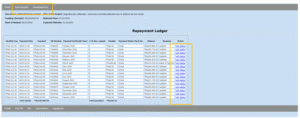
Figure 20: Ledger view
In the ledger view, the User can either Edit/Download/Print or Delete and also Add Payment. To add Payment, click the Add Payment button and fill in the entry boxes that constitute the parameters for adding Payment. When done, click Submit button to submit the entry. The User can either download or print the generated ledger of a project.

Figure 21: Add Payment

Figure 22: Download/Print Ledger

Figure 23: Intervention View
In the intervention view, the User can either Edit or Delete and also Add Intervention. To add Intervention, click the Add Intervention button and fill in the entry boxes that constitute the parameters for adding Intervention in Figure 27. When done, click Submit button to submit the entry. In the equipment view, the User can either Edit or Delete and also Add Equipment.

Figure 24: Add Intervention

Figure 25: Equipment View

Figure 26: Add Equipment
To add Equipment, click the Add Equipment button and fill in the entry boxes that constitute the parameters for adding Equipment. When done, click Submit button to submit the entry.

Figure 27: Generate Report
On the default page, click the Reports button to direct the User to the generation of report page.
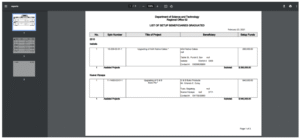
Figure 28: Report Generated
The User can either download or print the report generated.

Figure 29: Manage Files
Click the Manage Files button on the default page to lead the User to the management files/libraries (Province, Sector, Classification, Suppliers, Employees, Users) of the system. Viewed by the system administrator is this page. View/Edit/Delete and Add in the system libraries allows the system administrator to do. Clicking the Logout button will allow the User to leave the system and lead themselves to the main page (login form).
4. CONCLUSION
This study contained a summary of the findings that served as the foundation for any conclusion that is reached as a result of this research. Additionally, this study served as the basis for presenting suggestions that are derived from this research endeavour. The outcome demonstrates that the SETUP Project Monitoring and Management System was effectively built and put into operation. When it comes to the updating and synchronisation of data, it can be of great assistance to the regional office, including its provincial offices, in order to provide correct reports that can be sent to the central office and its corresponding clients. As a result, the RPMO is able to make use of the system that has been built in order to keep track of the progress of every project that is being monitored by the provincial offices. In a similar vein, the provincial offices have the ability to rapidly update and transmit the data that is monitored online. Additionally, the OUsecRO is able to examine and generate reports online based on the most recent data with this capability. Additionally, the cashier is able to already update the real-time subsidiary ledger that can be accessed online for the benefit of the consumers. As a consequence of the findings regarding the construction of the system, it has been determined that the most effective system is one that offers helpful information and allows for user engagement on all levels. When it comes to providing the end-user with the information they require, information systems should engage and communicate with them in the most effective way possible. A descriptive interpretation of “Very Great Extent” describes the level of compliance that the Developed System has with ISO 25010 in terms of functional suitability, performance efficiency, compatibility, usability, reliability, security, maintainability, and portability. The system has a score of 4.83. Using the identified issues and problems, the SETUP Project Monitoring and Management System for DOST was designed, developed, and tested. These issues and problems include the existing manual process of submitting monitoring reports and updating project status, updating subsidiary ledgers of customers, and providing a copy of subsidiary ledgers to its customers, among other things. These issues and problems can be incorporated into the online system to make the operations of the agency easier and to ensure that reports are generated quickly and accurately. It is possible that the system was able to immediately and appropriately handle the process operations and guidelines implementation at the regional office, which may be to the benefit of the project implementer as well as the customers of the project. The fact that the system was in accordance with ISO 25010, as determined by the respondents, is further demonstrated by this. The system that has been built can be put into operation by employing the algorithm that is suitable for the design, development, and testing of a project monitoring and management system for the Department of Science and Technology (DOST). There is room for additional improvement in the project monitoring and management system so that it can accommodate the preferences and choices of end-users. For the Department of Science and Technology Region 02, it is strongly suggested that they make use of the SETUP Project Monitoring and Management System (SPMAMS).
REFERENCES
- Hashmi, S. A., Ali, C. F., & Zafar, S. (2021). Internet of things and cloud computing‐based energy management system for demand side management in smart grid. International Journal of Energy Research, 45(1), 1007-1022.
- Wang, C., Qin, J., Qu, C., Ran, X., Liu, C., & Chen, B. (2021). A smart municipal waste management system based on deep-learning and Internet of Things. Waste Management, 135, 20-29.
- Oluyisola, O. E., Bhalla, S., Sgarbossa, F., & Strandhagen, J. O. (2022). Designing and developing smart production planning and control systems in the industry 4.0 era: a methodology and case study. Journal of Intelligent Manufacturing, 33(1), 311-332.
- Rehman, A., Saba, T., Kashif, M., Fati, S. M., Bahaj, S. A., & Chaudhry, H. (2022). A revisit of internet of things technologies for monitoring and control strategies in smart agriculture. Agronomy, 12(1), 127.
- Valinejadshoubi, M., Moselhi, O., Bagchi, A., & Salem, A. (2021). Development of an IoT and BIM-based automated alert system for thermal comfort monitoring in buildings. Sustainable Cities and Society, 66, 102602.
- Yitmen, I., Alizadehsalehi, S., Akıner, İ., & Akıner, M. E. (2021). An adapted model of cognitive digital twins for building lifecycle management. Applied Sciences, 11(9), 4276.
- Bwambale, E., Abagale, F. K., & Anornu, G. K. (2022). Smart irrigation monitoring and control strategies for improving water use efficiency in precision agriculture: A review. Agricultural Water Management, 260, 107324.
- Lv, X., & Li, M. (2021). Application and research of the intelligent management system based on internet of things technology in the era of big data. Mobile Information Systems, 2021(1), 6515792.
- Junaid, S. B., Imam, A. A., Balogun, A. O., De Silva, L. C., Surakat, Y. A., Kumar, G., … & Mahamad, S. (2022, October). Recent advancements in emerging technologies for healthcare management systems: a survey. In Healthcare (Vol. 10, No. 10, p. 1940). MDPI.
- Himeur, Y., Elnour, M., Fadli, F., Meskin, N., Petri, I., Rezgui, Y., … & Amira, A. (2023). AI-big data analytics for building automation and management systems: a survey, actual challenges and future perspectives. Artificial Intelligence Review, 56(6), 4929-5021.
- Akanmu, A. A., Anumba, C. J., & Ogunseiju, O. O. (2021). Towards next generation cyber-physical systems and digital twins for construction. Journal of Information Technology in Construction, 26.
- Dotsenko, N., Chumachenko, I., Kraivskyi, B., Railian, M., & Litvinov, A. (2024). Methodological support for managing of critical competences in agile transformation projects within a multi-project medical environment. Advanced Information Systems, 8(4), 26-33.
- Rao, A. S., Radanovic, M., Liu, Y., Hu, S., Fang, Y., Khoshelham, K., … & Ngo, T. (2022). Real-time monitoring of construction sites: Sensors, methods, and applications. Automation in Construction, 136, 104099.
- Rahman, A., Saha, R., Goswami, D., & Mintoo, A. A. (2024). Climate Data Management Systems: Systematic Review of Analytical Tools for Informing Policy Decisions. Frontiers in Applied Engineering and Technology, 1(01), 01-21.
- Alizadehsalehi, S., & Yitmen, I. (2023). Digital twin-based progress monitoring management model through reality capture to extended reality technologies (DRX). Smart and Sustainable Built Environment, 12(1), 200-236.
- Almalki, F. A., Soufiene, B. O., Alsamhi, S. H., & Sakli, H. (2021). A low-cost platform for environmental smart farming monitoring system based on IoT and UAVs. Sustainability, 13(11), 5908.
- Tran, M. Q., Elsisi, M., Mahmoud, K., Liu, M. K., Lehtonen, M., & Darwish, M. M. (2021). Experimental setup for online fault diagnosis of induction machines via promising IoT and machine learning: Towards industry 4.0 empowerment. IEEE access, 9, 115429-115441.
- Kostenetskiy, P. S., Chulkevich, R. A., & Kozyrev, V. I. (2021). HPC resources of the higher school of economics. In Journal of Physics: Conference Series (Vol. 1740, No. 1, p. 012050). IOP Publishing.
- Conti, M., Donadel, D., & Turrin, F. (2021). A survey on industrial control system testbeds and datasets for security research. IEEE Communications Surveys & Tutorials, 23(4), 2248-2294.
- Stolojescu-Crisan, C., Crisan, C., & Butunoi, B. P. (2021). An IoT-based smart home automation system. Sensors, 21(11), 3784.
- Benyezza, H., Bouhedda, M., & Rebouh, S. (2021). Zoning irrigation smart system based on fuzzy control technology and IoT for water and energy saving. Journal of Cleaner production, 302, 127001.
- Jamroen, C., Fongkerd, C., Krongpha, W., Komkum, P., Pirayawaraporn, A., & Chindakham, N. (2021). A novel UV sensor-based dual-axis solar tracking system: Implementation and performance analysis. Applied Energy, 299, 117295.
- Akinlolu, M., Haupt, T. C., Edwards, D. J., & Simpeh, F. (2022). A bibliometric review of the status and emerging research trends in construction safety management technologies. International Journal of Construction Management, 22(14), 2699-2711.
- Agostinelli, S., Cumo, F., Guidi, G., & Tomazzoli, C. (2021). Cyber-physical systems improving building energy management: Digital twin and artificial intelligence. Energies, 14(8), 2338.
- Ahmad, S., Shafiullah, M., Ahmed, C. B., & Alowaifeer, M. (2023). A review of microgrid energy management and control strategies. IEEE Access, 11, 21729-21757.
Publication History
Submitted: November 16, 2024
Accepted: November 24, 2024
Published: March 31, 2025
Identification
D-0408
DOI
https://doi.org/10.71017/djnsi.4.3.d-0408
Citation
Raquel B. Santos (2025). Setup Project Monitoring and Management System. Dinkum Journal of Natural & Scientific Innovations, 4(03):122-139.
Copyright
© 2025 The Author(s).


